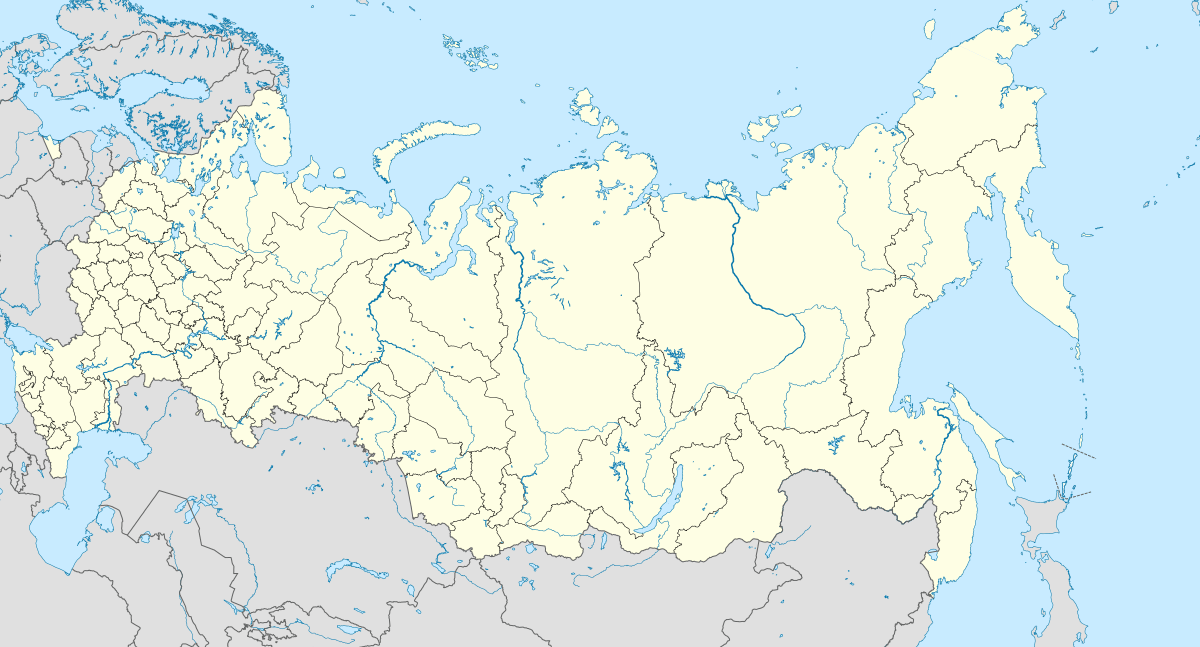Bolshoy Shantar Island
 The Shantar Islands in the Sea of Okhotsk | |
 Bolshoy Shantar Bolshoy Shantar Island (Russia) | |
| Geography | |
|---|---|
| Location | Sea of Okhotsk |
| Coordinates | 54°56′N 137°30′E / 54.933°N 137.500°E |
| Archipelago | Shantar Islands |
| Area | 1,766 km2 (682 sq mi) |
| Length | 72 km (44.7 mi) |
| Width | 49 km (30.4 mi) |
| Administration | |
| Federal Subject | Khabarovsk Krai |
Bolshoy Shantar is an island in the Sea of Okhotsk, Russia. It is the main island of the Shantar Islands. Its area is 1766 km². It is about 72 km (44.7 mi) in length and 49 km (30.4 mi) in width. It has a large brackish lake (Lake Bol'shoe) on its north side which is connected to the sea through a narrow passage. Yakshin Bay indents the southwest side of the island.
Administratively this island belongs to the Khabarovsk Krai of the Russian Federation.
History
The Shantar Islands were explored by Russian surveyors between 1711 and 1725.[1]
Bolshoy Shantar was frequented by American whaleships between 1852 and 1874. They hunted bowhead whales, particularly in the passages that separate Bolshoy Shantar from Feklistova and Prokofyeva. They also went ashore to obtain wood and water and hunt bears and foxes.[2][3] On 18 October 1858, the bark Rajah (250 tons), of New Bedford, was wrecked on the north side of the island during a strong gale. Captain Ansel N. Stewart, the first officer, and 11 other men perished; the second mate and the twelve other crew members were saved four days later by the ship Condor (349 tons), of New Bedford, Captain Samuel H. Whiteside. Five men, including the captain, were buried on the island.[4][5] Items from the wreck were found on the island as late as 1861.[6]
Flora and fauna
There are spruce forests on the island[7] and smelts (Hypomesus japonicus) and (H. olidus) are found in Lake Bol'shoe.[8] In the spring and summer Steller's sea eagle[9] and Aleutian tern nest on the island; long-billed murrelet also appear to breed here.[10]
Popular culture
This island is mentioned in Grand Theft Auto IV as the location of the headquarters of a fictional Peer-to-peer Programme called Shitster (a spoof of Napster.)
References
- ↑ From the History of the Great Russian Geographical Discoveries in the Arctic and Pacific Oceans in the Seventeenth and First Half of the Eighteenth Centuries. by A. V. Efimov
- ↑ Arctic, of Fairhaven, Aug. 1852. In Gelett, C. W. (1917). A life on the ocean: Autobiography of Captain Charles Wetherby Gelett. Honolulu, Hawaii: Hawaiian Gazette Co., Ltd.
- ↑ Harrison, of New Bedford, July 5–6, 1853, Nicholson Whaling Collection (NWC); Isabella, of New Bedford, July 8, 1854, NWC; Mary Frazier, of New Bedford, Aug. 28, 1855, NWC; Java, of New Bedford, Sep. 17–19, 1866, Kendall Whaling Museum (KWM); Sea Breeze, of New Bedford, Sep. 17, 23, 1874, G. W. Blunt White Library.
- ↑ The Friend, Honolulu, December 4, 1858, Vol. XV, No. 12, p. 93.
- ↑ Starbuck, Alexander (1878). History of the American Whale Fishery from Its Earliest Inception to the year 1876. Castle. ISBN 1-55521-537-8.
- ↑ Navy, of New Bedford, Sep. 9, 1861, KWM.
- ↑ Taiga in the Shantarskiye Islands
- ↑ Lake Bol'shoe
- ↑ Nigge, K. "The Russian Realm of Steller's sea-eagles". National Geographic, Vol. 195, No. 3 (March 1999): 60-71.
- ↑ Kondratyev, A. Y., Litvinenko, N. M., Shibaev, Y. V., Vyatkin, P. S., & Kondratyeva, L. F. (2000). The breeding seabirds of the Russian Far East. Seabirds of the Russian Far East, 37-81.
Coordinates: 54°56′N 137°30′E / 54.933°N 137.500°E